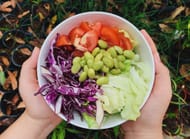Insulin resistance can be understood as a condition where the cells in your body do not respond effectively to insulin, which makes certain lifestyle changes, including an insulin resistance diet, necessary.
The inability of cells to respond effectively to insulin leads to your pancreas creating more insulin, which leads to a spike in your blood sugar levels. This could lead to type 2 diabetes, which is caused by the pancreas's inability to produce an adequate amount of insulin in response to your body's needs.
In this article, we will discuss the insulin resistance diet in greater depth, including the foods that one should eat and avoid.
What Is the Insulin Resistance Diet?
The Insulin Resistance Diet is a diet and lifestyle plan that will help you improve insulin resistance in your body, lowering your risk of type 2 diabetes and obesity.
The insulin resistance diet involves eating healthy and nutritious foods that are low in sugar and high in vitamins and minerals. You need to tailor this diet according to the needs of your body and routine.
A good diet will help you to effectively manage insulin resistance in your body, along with reducing the symptoms that are related to it.
What to eat on an Insulin Resistance Diet?
Certain nutritious foods, as well as avoiding some processed foods, should be included in your insulin resistance diet. Here is what you should eat:
Green vegetables – Vegetables such as kale and spinach tend to be packed with nutrients and are low in carbs. If you opt for canned or frozen vegetables, make sure that they do not include added sugar, salt, or fat.
Fruits – Fruits are also great choices for insulin resistance diets as they are filled with fiber, minerals, and vitamins. Sweet fruits like berries can also help you satisfy your dessert cravings.
High fiber foods – High fibre foods such as oatmeal, almonds, and lentils will help you regulate your blood sugar.

What Foods to Avoid on an Insulin Resistant Diet?
There are certain foods that you should severely limit when you are following an insulin resistant diet. These include:
Sweetened beverages: Beverages such as iced teas and sodas are high in sugar and can easily cause you to gain weight in the body.
Highly processed foods: Foods that have chemical additives and tend to have added salt, sugar, and fat should be avoided.
Saturated and trans fats: Cheese and meat will increase your insulin resistance.
Fried foods: Because they increase your blood sugar faster, fried foods should be avoided as well.
How Does Workout Effect Insulin Resistance?
The best workout routine that you can adopt for insulin resistance is a combination of resistance exercises and aerobic exercises. This workout combination will increase its effectiveness by improving insulin sensitivity. Regular workouts will transport glucose from your body to the muscles that are eventually used for energy.
You do not need to kill it in the gym to improve your health. Simply start with some small changes, such as walking for a few minutes after a meal which will eventually add up to your health. Lifestyle changes with regular exercise and a good diet will help in delaying type 2 diabetes and obesity.
Meal Planning Tips for an Insulin Resistance Diet
Here are some of the meal planning tips for an insulin resistance diet that will help you improve insulin resistance to quite an extent and will make your life easier:
1. Incorporate lean proteins in diet – You should try to incorporate as much lean protein as you can in your snacks and meals. This is because lean protein will help in maintaining stable blood sugar. Examples of lean proteins include tuna, chicken, fish, turkey, low-fat cheese, and more. Additionally, you should opt for grilled or baked foods.
2. Better intake of fiber – You should include fiber-filled versions of beans and whole grains. These include brown rice, oatmeal, popcorn, lentils, peas, and many more. Also, avoid foods that are high in carbs such as donuts and biscuits.
3. A high intake of non-starch vegetables – Increase your vegetable intake with foods such as spinach, onions, peppers, beets, broccoli, kale tomatoes, asparagus, and more.
Conclusion
Without the production of the required amount of insulin, your pancreas will eventually be unable to keep up. Your blood sugar levels will rise until you have prediabetes if you don't change how you eat and exercise.
Incorporate the aforementioned dietary plan and workout routine for a healthier and happier life!
